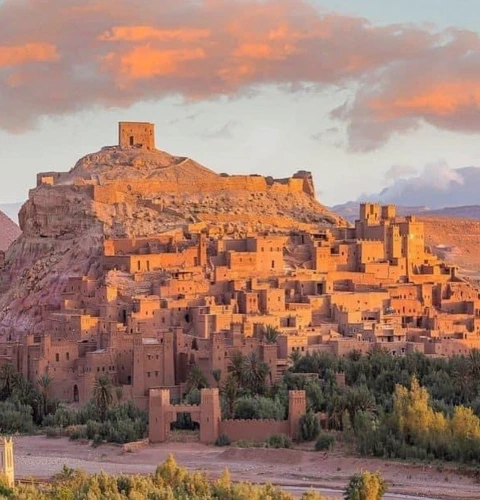
Blog
The Old Caravan Trails in Morocco: Trans-Saharan Routes Through Oasis Towns
Trace the old caravan trails in Morocco and discover the fascinating history of trans-Saharan caravan trading in Morocco. Learn about traditional routes and oasis stops along the way.
Introduction
For centuries, an intricate web of desert trails stretched across Morocco, traversed by camel trains laden with goods and tales from distant lands. These ancient trans-Saharan caravan routes established vital ties, both commercial and cultural, reaching far beyond North Africa. From the hushed dunes of the Sahara to the bustle of imperial cities, the rise and fall of Moroccan civilizations was indelibly tied to the ebb and flow of camel caravans. Their legacy lives on in crumbling kasbahs dotting remote oases, abandoned mines, and oral traditions still recounted.
Today, glimpses into this storied past captivate intrepid travelers willing to veer from well-worn tourist paths. As you bounce through river valleys in a 4×4 or ponder timeworn mudbrick towns that once lodged weary traders, Morocco’s crossroads history feels within reach. The desert roads echo with the footsteps of pilgrims, fortune seekers, and scholars who traveled these same trails centuries ago in pursuit of knowledge, riches, or faith. This guide will uncover the lore of Morocco’s caravan era and show you how to step into its lasting imprint even today.
Major Trans-Saharan Routes
Three main corridors channeled Morocco’s caravan trade:
- Marrakech to Timbuktu – Most famed route carrying gold, slaves, ivory south to Mali’s empires.
- Fez to Tafilalt Oasis – Connecting Fez with trading hubs like Sijilmasa. Salt and gold route.
- Tafilalt to Ghana – Linked Morocco’s southeast through the Draa Valley to storied Ghana.
Branch routes split throughout central Morocco to access key oases and commercial centers. Camel trains could take months reaching sub-Saharan destinations.
Historic Oasis Towns
Oases enabled caravan routes to cross the harsh desert:
- Ouarzazate – Strategic resting spot midway between Marrakech and the Mali route.
- Draa Valley – Chain of oases like Agdz, Tamnougalt, M’hamid supported route south.
- Zagora – Important salt trading center near the dunes. Signpost marked Timbuktu 52 days by camel.
- Erfoud – Known for date production. Last stop before the vast sand seas of Erg Chebbi.
From Zagora to Tamegroute, crumbling yet still inhabited oasis towns trace the legacy.
Traveling the Caravan Trails Today
Modern travelers can still traverse history:
- National roads like the N9, N10, and R203 parallel historic caravan roads.
- Oasis towns retain historic architecture like kasbahs from the trading heyday.
- Four-wheel drive tours follow segments of rugged ancient pistes through the desert.
- Camel treks provide immersive experiences retracing traditional caravan sojourns.
- Cultural museums like Marrakech’s Maison Tiskiwin exhibit caravan era artifacts.
Dunes and rocky plateaus may obscure the original trails, but their spirit endures.
Cultural Legacy of the Caravans
Morocco’s culture still echoes the cross-cultural exchange:
- Trade introduced new crops, textiles, and ideas that shaped Moroccan cuisine, dress, and crafts.
- Desert caravaneers brought musical instruments like theoud and gimbri that remain essential.
- Nomad storytelling traditions preserve folktales of daring and disaster along the routes.
- Caravanserai guesthouses offered weary traders places to rest and exchange stories.
From everyday handicrafts to lingering oral narratives, the caravan past remains woven through Moroccan life.
Preserving Caravan Heritage
Efforts today help conserve history for future generations:
- Restored forts and kasbahs allow glimpses into caravan era architecture and life.
- Desert museums like Ouarzazate’s exhibit artifacts from excavated ruins and historic sites.
- Cultural organizations promote Amazigh traditions and languages descended from caravanners.
- Music, crafts, and storytelling keep caravan history alive through folk arts.
- Heritage destinations along caravan routes promoted to tourists provide economic incentives.
- Recognition as UNESCO World Heritage sites highlights the routes’ significance.
Morocco balances preserving crumbling caravansarais with promoting living culture in dynamic ways.
While past splendor slips towards legends, Morocco actively sustains its caravan origins as a wellspring for future creativity and exchange.
Conclusion
The desert trails winding through Morocco were once pulsing arteries bridging cultures across continents. While collapsing kasbahs mark where caravans rested, the exchange they enabled still beats through Moroccan traditions today. By understanding these historic routes, we better comprehend the symbiosis linking Morocco with diverse African kingdoms over the centuries.
Though the age of trans-Saharan camel trains has passed, it left an invaluable legacy. As music echoes through sleepy oases and oral tales conjure images of Saharan journeying, Morocco proudly preserves its caravan foundations while forging a dynamic future. From the earthy tea sweetening tired travelers to the sacred festivals celebrating seasons of departure and return, the passages traversed were as influential as the goods carried. By walking in their footsteps, we reconnect to the human spirit that made exploration, discovery and connection under the desert stars possible.
Get Inspired and Plan Your Trip Today!
- Check out our Morocco Private Tours to see all the fantastic places you can visit in Morocco.
- Customize your own tour using the form on our website to create a vacation that is perfect for you.



FAQs
The caravan routes facilitated trade and cultural exchange between Morocco and sub-Saharan Africa for centuries. Camel trains carried goods like gold, salt, textiles and slaves.
Key routes led south from the cities of Marrakech, Fez, and villages in the Tafilalt oasis region towards famed Mali and the Niger River area.
Vital oases along the routes included Ouarzazate, Zagora, Tamegroute, Erfoud, and villages along the Draa Valley.
Yes, parts can be explored by 4×4, camel, or hiking through the desert. Museums also showcase artifacts and history.
The caravans introduced new handicrafts, crops, music like the gimbri lute, and architectural styles like kasbahs, and left a literary and oral tradition.
Arhhal
Moroccan Travel Expert
Plan an Entertaining Moroccan Holiday Now!
We can help you fit your stay and experience within your allotted budget.
